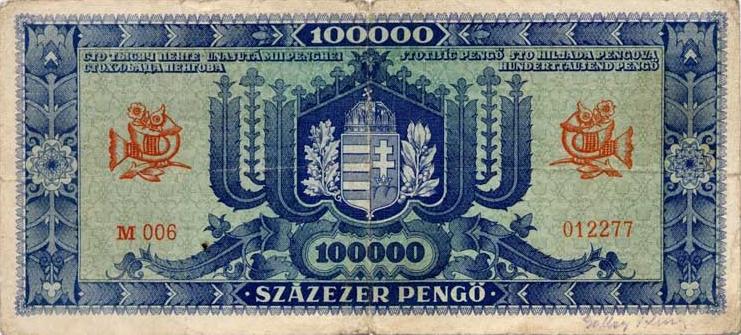Results 1 to 1 of 1
Thread Information
Users Browsing this Thread
There are currently 1 users browsing this thread. (0 members and 1 guests)
-
06-18-2009, 04:33 PM #1Senior Member


- Join Date
- May 2007
- Location
- South West Florida (Behind friendly lines but still in Occupied Territory)
- Posts
- 117,696
Hyperinflation: The Story of 9 Failed Currencies
Hyperinflation: The Story of 9 Failed Currencies
by Jason Lankow on 6/16/2009 Tags: economic downturn, inflation
The worldâs major economic powers are all suffering from the economic downturn but even the most cynical doomsayer is sure weâll get ourselves out of this messâeventually. Rare are those instances in which entire economies are disrupted to the point - typically as a result of rampant inflation, or hyper inflation - that an entire form of currency is discarded, reformed or replaced. But it does happen. There are invariably external issues (military, political, etc) at play, which result in what can generally be referred to the âfailure of a currencyâ, and each situation is unique. The following is a list of nine notable examples in which currencies became so devalued that they were eventually replaced:
Germany Weimer Republic 1922-1923

wikimedia
By the end of 1922 Germany found it was no longer able to pay the war reparations set forth by the Treaty of Versailles. French and Belgian armies responded by occupying Germanyâs most productive, and industrial regions. German industrialists then ordered workers strikes, which put further pressure on an already frail economy. The German government countered this situation by printing unbacked currency with which it meant to pay both workers benefits, as well as its delinquent international debt. Supply and demand followed: too much money was circulated, and the money was soon considered worthless. In 1922, the largest denomination of the Papiermark was 50,000. A year later it was 100 Trillion. This means that by December 1923, the exchange rate with the US Dollar was 4.2 Trillion to 1. It is estimated that by November 1923, the yearly inflation rate was considered 325,000,000%. This means that the cost of goods were increasing about every two days. As a result, the Rentenmark was introduced at a rate of 1 to 1 Trillion of the Papiermark. Reparation payments eventually continued, and France and Belgium agreed to leave the country.
Hungary 1945-1946

wikimedia
The Great Depression put an initial strain on the Austrian Pengo, originally introduced with great strength as a replacement to the Austrian-Hungarian Korona in 1926, per the Treaty of Versailles. Next, the associated effects of World War II would run their course. In 1944, the Hungarian Pengoâs highest denomination was the 1,000 note. A year later it was 10,000,000. And by mid-1946, it was 100,000,000,000,000,000,000. Realizing that this type of hyperinflation and denomination increase was not sustainable - and after 20 short years - the Pengo was replaced by the Forint. There are famous pictures of this event, which include street sweepers cleaning the sea of Pengo notes that Hungarians so eagerly discarded. At the time of this replacement, the Pengo to Forint exchange, was Four Hundred Octillion (Thatâs 29 Zeros) to one. That same Forint would exchange for 11.74 to $1USD. Inflation has since continued at a much more subdued rate, and the current exchange is valued at approximately 195.2 Forint to 1 $USD. It is estimated that at the time of replacement, the value of all Hungarian currency in circulation equaled less than one-thousandth of one US dollar!
Chile 1971-1981
wikimedia
Shortly after the ascension to the office of president, Socialist President Salvador Allende, decreed that many of Chileâs leading industries would be nationalized. Owing predominately to management problems (with bureaucrats overseeing the market) this government soon began hemorrhaging money, and in order to subsidize the loss, the Chilean Central Bank began printing unbacked currency at an alarming rate. This resulted in an inflation rate of 600% by the end of 1972; inflation eventually skyrocketed to 1200% by the end of 1973. This was the same year General Augusto Pinochetâs US-backed coup dâétat seized control and installed his populist military regime. Shortly thereafter, in 1985, the Escudo (1960-1975) was replaced by the New Peso at a rate of 1,000 to 1. Except for a slight depression in 1981, the Chilean economy recovered, largely due to the governmentâs decision to sell off newly acquired State-owned enterprises. The rest of Pinochetâ s tenure in Chile, however, is entirely another story.
Argentina 1975-1992

wikimedia
After unprecedented annual growth rates and record trade surpluses, panic and political unrest broke out between Argentine Trotskyists and the Perón loyalists, in the wake of the 1973 oil crisis. Conflict came to a head in 1975, when a sharp recession looked inevitable. The Argentine government then exacerbated the situation by refusing to borrow in order to cover its budget and trade deficits. In 1975, the largest Argentine Peso denomination was 1,000. A year later the 5,000 note was introduced. In March 1976, a violent coup was staged by the countryâs military leaders, who promised to bring stability to the region. By â79, there was a 10,000 Peso banknote and by 1981, the Argentine Central Bank had introduced a 1,000,000 Peso note. The countryâs economy declined, further worsening the situation - in between 1981 and 1982, Argentinaâs GDP fell 12%, the worst single year decline since The Great Depression. When the currency was reformed in 1983, 1 Peso Argentino was exchanged for 10,000 of the âoldâJoin our efforts to Secure America's Borders and End Illegal Immigration by Joining ALIPAC's E-Mail Alerts network (CLICK HERE)


 LinkBack URL
LinkBack URL About LinkBacks
About LinkBacks





 Reply With Quote
Reply With Quote

500,000 Illegals Caught on Arizona Ranch
05-02-2024, 09:08 AM in illegal immigration News Stories & Reports